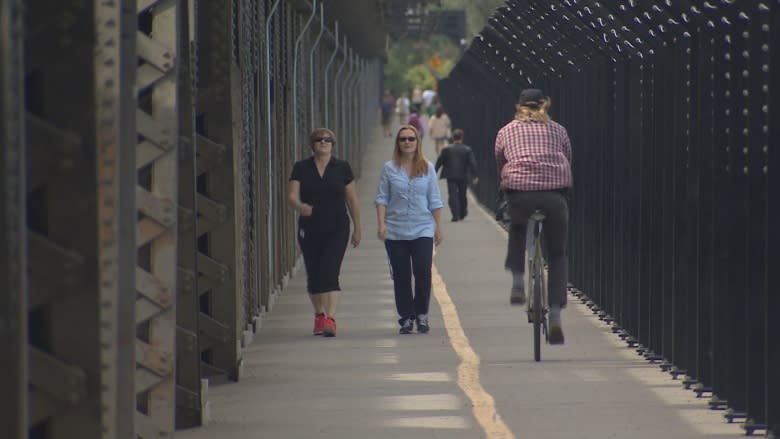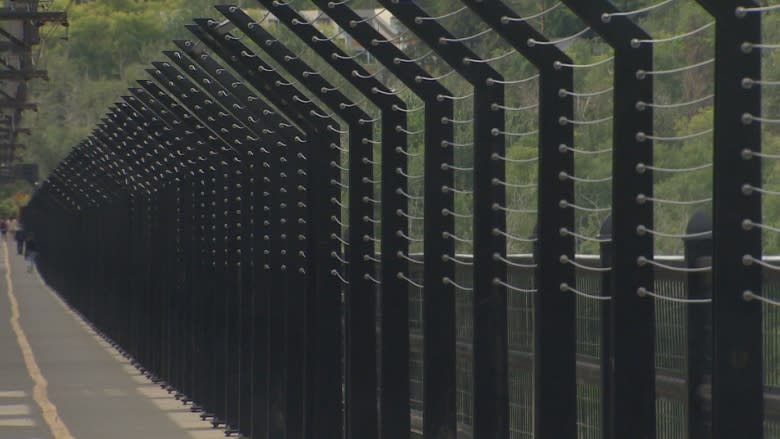'Tired of getting lectured,' Edmonton mayor suggests partial bike ban may be needed for High Level bridge
Some cyclists are asking the city to come up with a new plan for safety on the High Level Bridge after Mayor Don Iveson suggested bicycle riding might have to be restricted on the busy route.
Cyclists are complaining that new barriers, intended to dissuade suicide attempts, have narrowed the sidewalks and created congestion on either side of the bridge.
Iveson said design concerns might be addressed by either asking cyclists to walk their bikes across the bridge, or by banning bikes on the narrow east side sidewalk.
"If it becomes necessary, because of accidents and input from users, that we have to turn the east side into a proper sidewalk and keep the west side as the shared use pathway that you can continue to ride — that's something that will be evaluated and a decision will be made."
Iveson said users frustrated over the fight for space have forgotten the big picture.
"Even though I know there is a great deal of frustration about this, I personally know three people that have committed suicide off that bridge," Iveson said during an interview with CBC Radio's Edmonton AM. "And I'm getting a little tired of getting lectured by folks that say this was not a good move for city council.
"The evidence was there that this bridge had become a suicide hotspot. Council felt compelled to act. That's why the barriers are there."
Later, Iveson said he wanted to clarify his position on cyclists having to walk their bikes.
"It might become necessary at some point to require dismount," he told reporters. "But that's something that's being monitored, it's not something that's being implemented any time soon, unless conditions deteriorate."
Tight squeeze
The $3-million barriers were approved in December 2014 and installation began last year.
The east-side path is now just 2.3 metres wide — much smaller than the three-metre national minimum standards for a multi-use trail. And with up to 4,000 cyclists and pedestrians each day, the bridge is Edmonton's busiest cycling corridor.
Edmonton cyclist Tom Engel says the tight squeeze along the sidewalks is creating real hazards for cyclists and pedestrians alike.
Two weeks ago, after crashing his bike on the bridge, Engel was taken to hospital with scrapes and bruises, a gash across his face, a puncture wound in his side and a fractured rib.
He was swerving to avoid a pedestrian when he lost control.
"That caused me to go to the right and straight into one of those big girders, right over the handlebars. Head first into the girder," he said. "And I ended up pinned between the restraining cable and the girder."
Although Engel acknowledges the need for the barriers, he says the design needs of the busy corridor were completely overlooked. Iveson's proposed solutions are nonsensical, he suggested.
"I don't think they even thought about it. I don't think the thought even crossed their minds when they designed this," said Engel. "You ride a bike to ride, and to make people walk, that's a pretty long walk."
'Not a good design'
There have been more than 60 collisions and near-misses on the bridge in the last two weeks, according to an informal survey by the Edmonton Bicycle Commuters Society.
"This is clearly not a good design," said Chris Chan, the society's executive director. "You're causing injuries by having put up this barrier. which I don't think that was anyone's intention, but it's quite evident that there are problems.
"Part of it is the width, but another part of it is the design. You don't have anything to prevent your handlebars from getting hooked on the girders on one side, or the barriers on the other side."
Chan says Iveson's plan will only aggravate congestion along the bridge.
"It's kind of disappointing. It's really not what we want to hear."
If a widening of the route is not possible, Chan suggests the city alleviate safety concerns by adding grab rails to reduce snags, and improve education on pedestrian etiquette.
Furthermore, Chan says if cyclists are barred from the east sidewalk, the intersections along 109th Street will need to be upgraded to ease congestion.
"The solution isn't to make things even worse for pedestrians and cyclists by preventing them from using either side of the bridge," said Chan. "The solution is really to fix those design problems."


